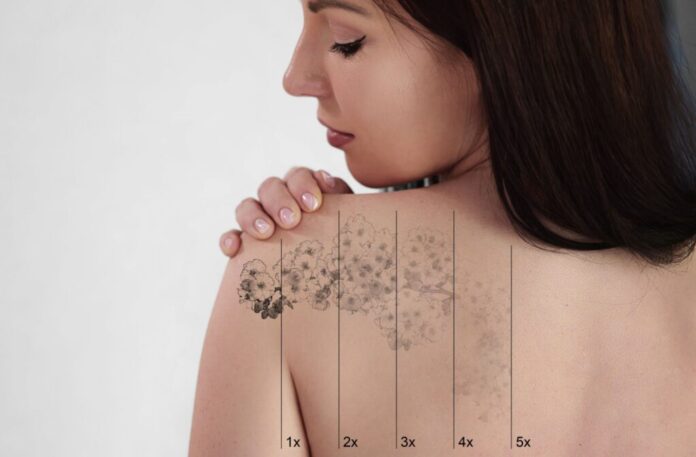Laser tattoo removal is a non-invasive procedure that uses concentrated light energy to break down the ink particles in tattoos. It has become the gold standard for removing unwanted tattoos due to its effectiveness and precision. In recent years, many individuals have turned to Laser Tattoo Removal in Dubai as a reliable solution for removing old or unwanted body art. This procedure allows people to reverse a decision that once seemed permanent and often does so with minimal side effects.
What Makes Laser Tattoo Removal So Effective?
The science behind laser tattoo removal lies in the selective photothermolysis process. It is a highly targeted method that heats and shatters the ink particles without causing harm to the surrounding skin tissue.
Key Factors Contributing to Effectiveness:
- Wavelength specificity: Different wavelengths target specific ink colors
- Pulse duration: Short pulses break the pigment into smaller particles
- Cooling technology: Protects skin and enhances comfort
How Ink is Broken Down by Lasers
Each laser pulse delivers a burst of energy that is absorbed by the tattoo pigment. This energy causes the ink particles to fragment into smaller pieces, which are then gradually removed by the body’s immune system.
Breakdown Process:
- Light penetrates the skin and reaches the tattoo pigment
- Ink absorbs light and shatters into tiny fragments
- White blood cells flush out ink via the lymphatic system
Table: Common Laser Wavelengths and Their Target Colors
| Laser Type | Wavelength (nm) | Target Ink Colors |
|---|---|---|
| Q-switched Nd:YAG | 1064 | Black, dark blue |
| Q-switched Nd:YAG | 532 | Red, orange, yellow |
| Alexandrite | 755 | Green, blue |
Types of Lasers Used in Tattoo Removal
Not all tattoos are created equal, and neither are all lasers. The type of laser used depends on the color and depth of the ink.
Most Common Lasers:
- Q-switched Nd:YAG: Best for darker skin tones and deeper ink
- Q-switched Ruby: Ideal for green and blue inks
- PicoSure Laser: Offers faster removal and is suitable for most colors
Multiple Sessions: Why Are They Necessary?
Complete tattoo removal typically requires multiple sessions, spaced several weeks apart. This allows the skin to heal and the body to process and eliminate fragmented ink.
Factors Influencing Session Count:
- Tattoo age and depth
- Ink density and colors
- Body location and skin type
Estimated Number of Sessions Based on Tattoo Characteristics
| Tattoo Feature | Estimated Sessions |
|---|---|
| Small black ink only | 3–5 sessions |
| Multi-colored ink | 6–10 sessions |
| Dense or layered ink | 8–12+ sessions |
The Role of the Immune System in Tattoo Removal
Once the ink is broken down by the laser, the immune system plays a vital role in removing the particles from the body.
How the Body Responds:
- Macrophages digest ink fragments
- Ink is transported to the lymph nodes
- Gradual fading of the tattoo with time
Skin Types and Tattoo Colors: Customizing the Treatment
Different skin types and ink colors respond differently to lasers. Customizing the treatment plan is crucial for maximizing effectiveness and minimizing side effects.
Skin Type Considerations:
- Lighter skin absorbs less laser energy, making treatment easier
- Darker skin requires lower energy to avoid pigment changes
Ink Color Challenges:
- Black ink responds best to lasers
- Yellow, green, and blue may require advanced laser types
Laser Tattoo Removal vs. Other Methods
Traditional tattoo removal methods like dermabrasion, surgical excision, or salabrasion carry risks and often leave scarring. Laser treatment is superior due to its non-invasive nature and reduced healing time.
Comparison Table: Laser vs. Traditional Methods
| Method | Invasiveness | Scarring Risk | Precision | Downtime |
|---|---|---|---|---|
| Laser Removal | Non-invasive | Low | High | Minimal |
| Dermabrasion | Invasive | High | Low | Moderate |
| Surgical Excision | Invasive | Moderate | Moderate | High |
How to Prepare for a Laser Tattoo Removal Session
Proper preparation helps optimize results and ensure a smoother experience. While the treatment itself is straightforward, a few preparatory steps can make a difference.
Pre-Treatment Tips:
- Avoid sun exposure for two weeks prior to
- Shave the area on the day of treatment
- Avoid applying creams or lotions
Aftercare and Healing
Post-procedure care is essential to prevent complications and promote effective healing. Proper care can also reduce the number of sessions required.
General Aftercare Guidelines:
- Keep the area clean and dry
- Avoid scratching or picking at the site
- Apply healing ointments if recommended
- Wear loose clothing over the area
Table: Typical Healing Timeline
| Time Frame | What to Expect |
|---|---|
| 1–3 days | Redness, swelling, mild pain |
| 1 week | Scabbing or peeling |
| 2–3 weeks | Fading begins |
| 4–6 weeks | Redness, swelling, and mild pain |
Who Can Benefit from Laser Tattoo Removal?
This treatment is ideal for anyone seeking to eliminate or significantly fade an unwanted tattoo. It suits a wide demographic, from professionals to individuals rethinking a past decision.
Common Motivations for Removal:
- Professional appearance requirements
- Personal or aesthetic reasons
- Correcting tattoo mistakes
FAQ’s:
1. Is Laser Tattoo Removal Painful?
Laser tattoo removal is generally tolerable. Most people compare it to a rubber band snap. Cooling systems or topical numbing creams may be used to ease discomfort.
2. How Long Does a Single Session Take?
A single session typically lasts 15–30 minutes, depending on tattoo size and ink complexity.
3. Can All Tattoo Colors Be Removed?
While black ink is easiest to remove, colors like green, yellow, and blue may require more sessions or advanced lasers.
4. Will My Skin Be the Same After Removal?
Most people experience normal skin texture after healing, though a slight ghost image may remain for deeply pigmented tattoos.
5. How Soon Can I See Results?
Fading can be noticeable after 1–2 sessions, but complete results often require multiple visits spaced weeks apart.
Conclusion:
Laser technology continues to evolve, making the procedure more accessible and effective than ever. Whether it’s a faded memory or an artistic choice gone wrong, Laser Tattoo Removal provides a reliable and efficient way to erase tattoos with minimal discomfort and long-term results.































